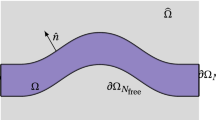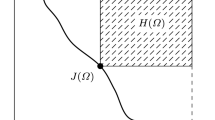Abstract
Ceramic is a material frequently used in industry because of its favorable properties. Common approaches in shape optimization for ceramic structures aim to minimize the tensile stress acting on the component, as it is the main driver for failure. In contrast to this, we follow a more natural approach by minimizing the component’s probability of failure under a given tensile load. Since the fundamental work of Weibull, the probabilistic description of the strength of ceramics is standard and has been widely applied. Here, for the first time, the resulting failure probabilities are used as objective functions in PDE constrained shape optimization. To minimize the probability of failure, we choose a gradient based method combined with a first discretize then optimize approach. For discretization finite elements are used. Using the Lagrangian formalism, the shape gradient via the adjoint equation is calculated at low computational cost. The implementation is verified by comparison of it with a finite difference method applied to a minimal 2d example. Furthermore, we construct shape flows towards an optimal / improved shape in the case of a simple beam and a bended joint.










Similar content being viewed by others
References
Weibull, E.: A statistical theory of the strength of materials. Ingeniörsvetenskapsakedemiens Handlingar 151, 1–45 (1939)
Munz, D., Fett, T.: Ceramics—Mechanical Properties, Failure Behaviour, Materials Selection. Springer, Berlin (1999)
Nemeth, N.N., Manderscheid, J., Gyekenyeshi, J.: Ceramic analysis and reliability evaluation of structures (CARES). Report TP-2916, NASA (1990)
Roudi, S., Riesch-Oppermann, H., Kraft, O.: Advanced probabilistic tools for the uncertainty as- sessment in failure and lifetime prediction of ceramic components. Materialwiss. Werkstofftech. 36, 171–176 (2005)
Lohbauer, U., Petschelt, A., Greil, P.: Lifetime prediction of cad/cam dental ceramics. J. Biomed. Mater. Res. 63(6), 780–785 (1973)
Allaire, G.: Shape Opimization by the Homogenisation Method. Springer, Berlin (2001)
Bucur, D., Buttazzo, G.: Variational Methods in Shape Optimization Problems. Birkhäuser, Basel (2005)
Chenais, D.: On the existence of a solution in a domain identification problem. J. Math. Anal. Appl. 52, 189–289 (1975)
Haslinger, J., Mäkinen, R.A.E.: Introduction to Shape Optimization. SIAM, New Delhi (2003)
Sokolovski, J., Zolesio, J.P.: Introduction to Shape Optimization—Shape Sensitivity Analysis. Springer, Berlin (1992)
Bolten, M., Gottschalk, H., Schmitz, S.: Minimal failure probability for ceramic design via shape control. J. Optim. Theory Appl. 166(3), 983–1001 (2015)
Gottschalk, H., Schmitz, S.: Optimal reliability in design for fatigue life. SIAM J. Control Optim. 52(5), 2727–2752 (2015)
Schmitz, S.: A Local and Probabilistic Model for Low-Cycle Fatigue: New Aspects of Structural Analysis. Hartung-Gorre, Konstanz (2014)
Mohammadi, B., Pironneau, O.: Applied Shape Optimization for Fluids. Oxford university Press, Oxford (2001)
Frey, C., Nürnberger, D., Kersken, H.: The discrete adjoint of a turbomachinery rans solver. In: Proceedings of ASME-GT2009 (2009)
Bendsøe, M.P., Sigmund, O.: Topology Optimization. Springer, Berlin (2004)
Conti, S., Held, H., Pach, M., Rumpf, M., Schultz, R.: Shape optimization under uncertainty—a stochastic programming perspective. SIAM J. Optim. 19(4), 1610–1632 (2008)
Batendorf, S.B., Crosse, J.G.: A statistical theory for the fracture of brittle structures subject to nonuniform polyaxial stress. J. Appl. Mech. 41, 459–465 (1974)
Duran, R.G., Muschietti, M.A.: The korn inrequality for jones domains. Electron. J. Diff. Equ. 127, 1–10 (2004)
Brückner-Foit, A., Fett, T., Munz, D., Schirmer, K.: Discrimination of multiaxiality criteria with the brasilian disk test. J. Eur. Ceram. Soc. 17, 689–696 (1997)
Gross, D., Seelig, T.: Fracture Mechanics with an Introduction to Micromechanics. Springer, Berlin (2006)
Watanabe, S.: On discontinuous additive functionals and lévy measures of a markov process. Jpn. J. Math. 34, 53–70 (1964)
Kallenberg, O.: Random Measures. Akademie, Berlin (1983)
Bäker, M., Harders, H., Rösler, J.: Mechanisches Verhalten der Werkstoffe, 3rd edn. Vieweg+Teubner, Berlin (2008)
Braess, D.: Finite elements. Theory, Fast Solvers, and Applications in Solid Mechanics. Cambridge University Press, Cambridge (1997)
Trefethen, L.N., Weideman, J.A.C.: The exponentially convergent trapezoidal rule. SIAM Rev. 56(3), 385–458 (2014)
Ivanov, S.N., Khazanov, E.N., Taranov, A.V., Mikhailova, I.S., Gropyanov, V.M., Abramovich, A.A.: Grain boundaries and elastic properties of aluminum-oxide and stainless-steel-based cermets. Phys. Solid State 43(4), 665–669 (2001)
Nazarov, S., Plamenevskij, B.A.: Elliptic Boundary Value Problems in Domains with Piecewise Smooth Boundary. De Gruyter, Berlin (1994)
Agmon, S., Douglis, A., Nirenberg, L.: Estimates near the boundary for solutions of elliptic partial differential equations satisfying general boundary conditions i. Commun. Pure Appl. Math. 12(4), 623–727 (1959)
Agmon, S., Douglis, A., Nirenberg, L.: Estimates near the boundary for solutions of elliptic partial differential equations satisfying general boundary conditions ii. Commun. Pure Appl. Math. 17(1), 35–92 (1964)
Ciarlet, P.: Mathematical Elasticity-Volume I: Three-Dimensional Elasticity Studies in mathematics and its applications. North-Holland, Amsterdam (1988)
Acknowledgements
Hanno Gottschalk thanks Sebastian Schmitz from Siemens Energy, Gas Turbine Engineering Department, for interesting discussions. This work was supported by BMBF (German Federal Ministry for Education and Research) as part of the project GIVEN (05M18PXA).
Author information
Authors and Affiliations
Corresponding author
Additional information
Gabriel Wittum.
Publisher's Note
Springer Nature remains neutral with regard to jurisdictional claims in published maps and institutional affiliations.
Rights and permissions
About this article
Cite this article
Bolten, M., Gottschalk, H., Hahn, C. et al. Numerical shape optimization to decrease failure probability of ceramic structures. Comput. Visual Sci. 21, 1–10 (2019). https://doi.org/10.1007/s00791-019-00315-z
Received:
Accepted:
Published:
Issue Date:
DOI: https://doi.org/10.1007/s00791-019-00315-z




